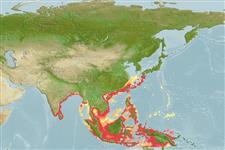Issue
Genus Eschmeyer, pers. comm.
Environment: milieu / climate zone / depth range / distribution range
Ecologie
marien; brak water demersaal; amfidroom (Ref. 51243); diepte 16 - 73 m (Ref. 57343). Tropical; 37°N - 11°S, 75°E - 149°E
Eastern Indian Ocean and Western Pacific: southwestern India to Papua New Guinea, north to Japan. May rarely occur in the Philippines, eastern Indonesia, and Papua New Guinea (Ref. 57343). Not in Red Sea (Ref. 84159).
Grootte / Gewicht / Leeftijd
Maturity: Lm ? range ? - ? cm
Max length : 30.0 cm TL mannelijk / geslacht onbekend; (Ref. 30573); common length : 20.0 cm TL mannelijk / geslacht onbekend; (Ref. 30573)
Dorsale stekels (totaal) : 9; Dorsale zachte stralen (totaal) : 12 - 13; Anale stekels: 3; Anale zachte stralen: 11 - 13; Wervels: 24. With 6 pectoral filaments; uppermost not reaching posterior tip of pectoral fin. Pectoral fin, rays moderate, 19-25% of SL; all rays branched except uppermost 1 or 2. Second dorsal spine short, 5-8% of SL. Atrophied swim bladder, like a string. A large black spot anteriorly on lateral line (Ref. 40958, 41110). No upper lip; lower lip well-developed except at symphysis. Operculum broadly rounded; preoperculum coarsely serrated. Color is golden-olive above ,silvery below. A large oval blotch is at the start of the lateral line (Ref. 561).
A marine species found on sandy and muddy bottoms of the continental shelf (Ref. 4340, 11230, 57343). Frequently enters estuaries (Ref. 9685, 11230). Feeds mainly on small crustaceans (especially shrimps), fishes and benthic organisms; also on sponges and fish scales (Ref. 9685). The progression in this hermaphrodite is protandrous, changing from a juvenile to a hermaphrodite, then a female (Ref. 9685).
Levenscyclus en paargedrag
Maturities | Voortplanting | Spawnings | Egg(s) | Fecundities | Larven
Motomura, H., 2004. Threadfins of the world (Family Polynemidae). An annotated and illustrated catalogue of polynemid species known to date. FAO Spec. Cat. Fish. Purp. Rome: FAO. 3:117 p. (Ref. 57343)
Status op de Rode Lijst van het IUCN (Ref. 130435)
Gevaar voor de mens
Harmless
Gebruik door de mens
Visserij: commercieel; sportvis: ja
Tools
Speciale rapporten
Download XML
Internetbronnen
Estimates based on models
Preferred temperature (Ref.
123201): 23.5 - 28.4, mean 27.7 °C (based on 227 cells).
Fylogenetische diversiteitsindex (Ref.
82804): PD
50 = 0.5000 [Uniqueness, from 0.5 = low to 2.0 = high].
Bayesian length-weight: a=0.01479 (0.00929 - 0.02354), b=3.04 (2.91 - 3.17), in cm total length, based on LWR estimates for this species & (Sub)family-body (Ref.
93245).
Trofisch niveau (Ref.
69278): 3.8 ±0.57 se; based on food items.
Generation time: 3.0 ( na - na) years. Estimated as median ln(3)/K based on 1
growth studies.
Weerstandsvermogen (Ref.
120179): Gemiddeld, minimale populatieverdubbelingstijd 1,4-4,4 jaar (Preliminary K or Fecundity.).
Fishing Vulnerability (Ref.
59153): Low to moderate vulnerability (31 of 100).
